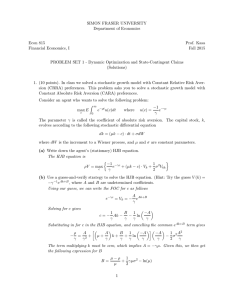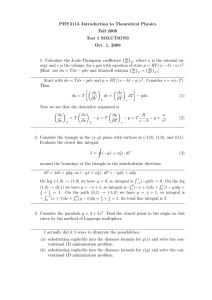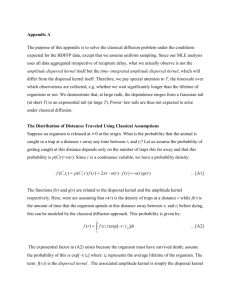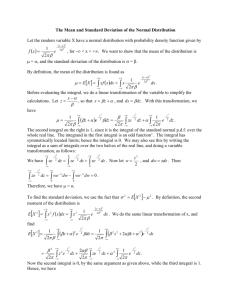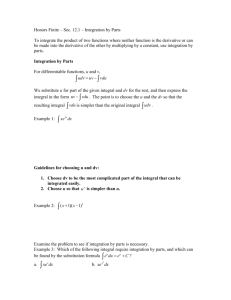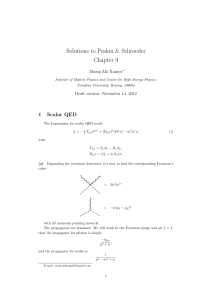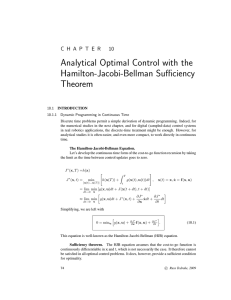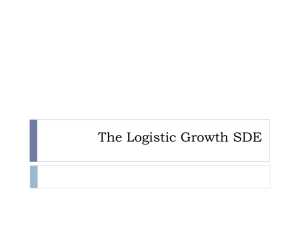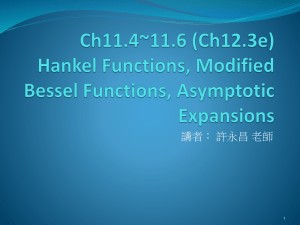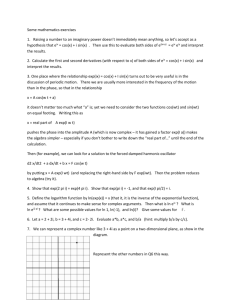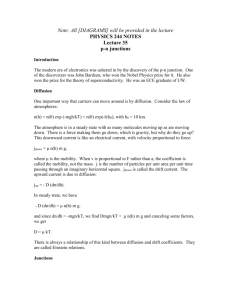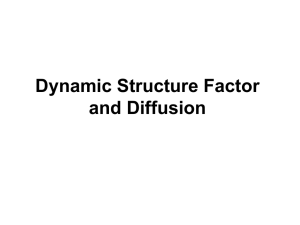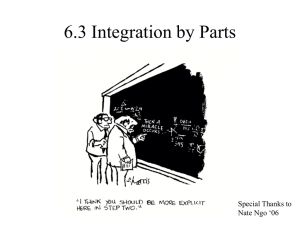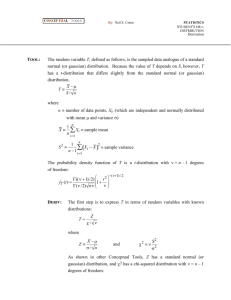Ch 17. Optimal control theory and the linear Bellman equation
advertisement
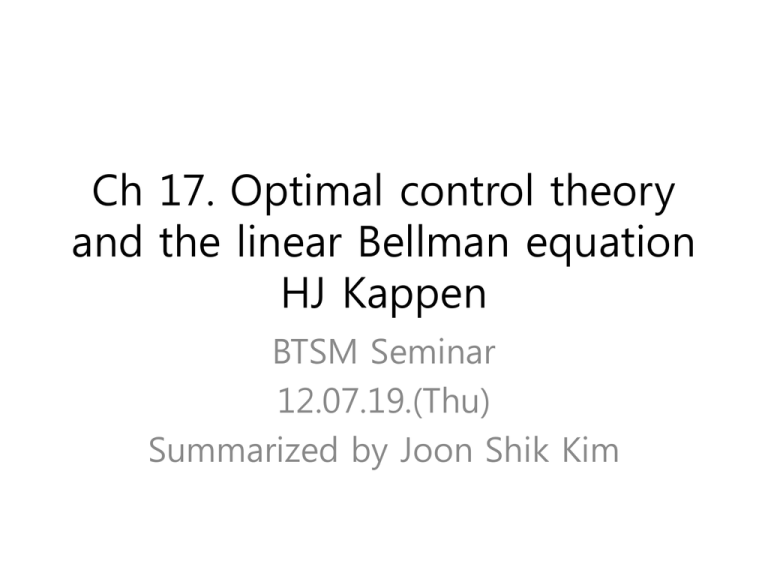
Ch 17. Optimal control theory
and the linear Bellman equation
HJ Kappen
BTSM Seminar
12.07.19.(Thu)
Summarized by Joon Shik Kim
Introduction
• Optimising a sequence of actions to attain some
future goal is the general topic of control theory.
• In an example of a human throwing a spear to kill
an animal, a sequence of actions can be assigned a
cost consists of two terms.
• The first is a path cost that specifies the energy
consumption to contract the muscles.
• The second is an end cost that specifies whether the
spear will kill animal, just hurt it, or miss it.
• The optimal control solution is a sequence of motor
commands that results in killing the animal by
throwing the spear with minimal physical effort.
Discrete Time Control (1/3)
• x t 1 x t f ( t , x t , u t ), t 0,1, ..., T 1,
where xt is an n-dimensional vector describing the
state of the system and ut is an m-dimensional vector
that specifies the control or action at time t.
• A cost function that assigns a cost to each sequence
of controls
T 1
C ( x 0 , u 0:T 1 ) ( x T )
R (t , x , u
t
t0
t
)
where R(t,x,u) is the cost associated with taking
action u at time t in state x, and Φ(xT) is the cost
associated with ending up in state xT at time T.
Discrete Time Control (3/3)
• The problem of optimal control is to find
the sequence u0:T-1 that minimises
C(x0, u0:T-1).
• The optimal cost-to-go
J ( t , x t ) m in ( x T )
u t :T 1
T 1
st
R ( s, xs , u s )
m in ( R ( t , x t , u t ) J ( t 1, x t f ( t , x t , u t ))).
ut
Discrete Time Control (1/3)
• The algorithm to compute the optimal
control, trajectory, and the cost is given
by
• 1. Initialization: J (T , x ) ( x ).
• 2. Backwards: For t=T-1,…,0 and for x
compute
u t ( x ) arg m in{ R ( t , x , u ) J ( t 1, x f ( t , x , u ))},
*
u
J ( t , x ) R ( t , x , u t ) J ( t 1, x f ( t , x , u t )).
*
*
• 3. Forwards: For t=0,…,T-1 compute
x t 1 x t f ( t , x t , u t ( x t )).
*
*
*
*
*
The HJB Equation (1/2)
•
J ( t , x ) m in ( R , x , u ) dt J ( t dt , x f ( x , u , t ) dt )),
u
m in ( R ( t , x , u ) dt J ( t , x ) t J ( t , x ) dt x J ( t , x ) f ( x , u , t ) dt ),
u
•
t J ( t , x ) m in ( R ( t , x , u ) f ( x , u , t ) x J ( x , t )).
u
(Hamilton-
Jacobi-Belman equation)
• The optimal control at the current x, t is
given by
u ( x , t ) arg m in ( R , u , t ) f ( x , u , t ) x J ( t , x )).
u
• Boundary condition is
J ( x , T ) ( x ).
The HJB Equation (2/2)
Optimal control of mass on a spring
Stochastic Differential Equations
(1/2)
• Consider the random walk on the line
x t 1 x t t , t ,
with x0=0.
t
• In a closed form, x t i 1 i .
• x t 0, x t .
• In the continuous time limit we define
2
t
(Wiener Process)
dx t x t dt x t d
• The conditional probability distribution
( x , t | x 0 , 0)
( x x0 ) 2
exp
2 t
2 t
1
.
Stochastic Optimal Control Theory
(2/2)
• dx f ( x ( t ), u ( t ), t ) dt d
• dξ is a Wiener process with
d d ( t , x , u ) dt .
• Since <dx2> is of order dt, we must
make a Taylor expansion up to order dx2.
i
j
ij
1
2
t J ( t , x ) m in R ( t , x , u ) f ( x , u , t ) x J ( x , t ) ( t , x , u ) x J ( x , t ) .
u
2
Stochastic Hamilton-Jacobi-Bellman equation
dx f ( x , u , t ) dt : drift
dx ( t , x , u ) dt : diffusion
2
Path Integral Control (1/2)
• In the problem of linear control and
quadratic cost, the nonlinear HJB
equation can be transformed into a
linear equation by a log transformation
of the cost-to-go. J ( x , t ) log ( x , t ).
HJB becomes
1
V
T
T
2
t ( x , t ) f T r ( g g ) .
2
Path Integral Control (2/2)
• Let ( y , | x , t ) describe a diffusion process
for t defined Fokker-Planck equation
V
( x, t )
( f )
T
dy ( y , T
1
2
T r ( g g ) .
2
T
| x , y ) exp( ( y ) / ).
(1)
The Diffusion Process as a Path
Integral (1/2)
• Let’s look at the first term in the
equation 1 in the previous slide. The first
term describes a process that kills a
sample trajectory with a rate of V(x,t)dt/λ.
• Sampling process and Monte Carlo
dx f ( x , t ) dt g ( x , t ) d ,
x x dx , With probability 1-V(x,t)dt/λ,
xi † ,
( x, t )
with probability V(x,t)/λ, in this case, path is killed.
dy ( y , T
| x , t ) exp( ( y ) / )
1
N
i alive
exp( ( x i ( T )) ).
The Diffusion Process as a Path
Integral (2/2)
•
p ( x (t T ) | x , t )
1
exp S ( x ( t T )) .
( x, t )
1
where ψ is a partition function, J is a freeenergy, S is the energy of a path, and λ
the temperature.
Discussion
• One can extend the path integral control
of formalism to multiple agents that
jointly solve a task. In this case the
agents need to coordinate their actions
not only through time, but also among
each other to maximise a common
reward function.
• The path integral method has great
potential for application in robotics.
